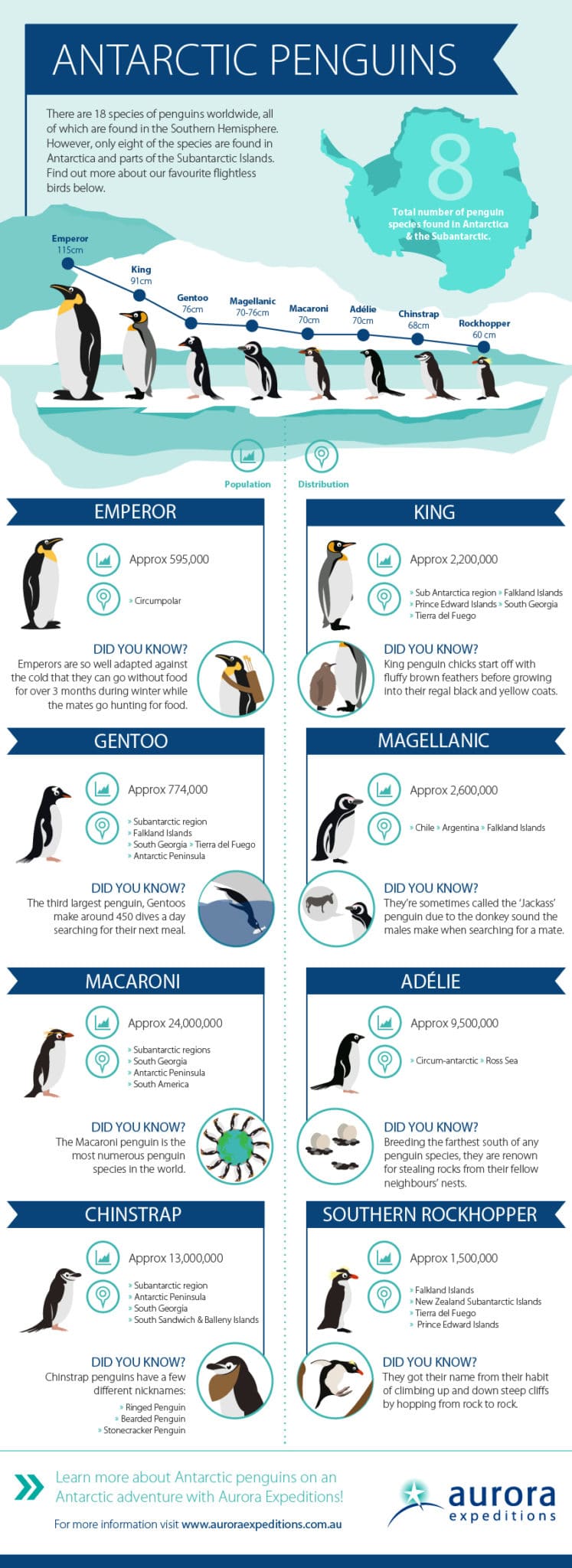It's time to refresh your penguin knowledge!
Of all Antarctica's resident animals, penguins are some of the most iconic and well-known. Whether it's their signature waddling walk, their tuxedo black and white feathers or the way they slide across the ice and dive into the icy water, there is a lot to love about penguins.
View our Antarctic Penguin Infographic below.
Of the 18 species found in the Southern Hemisphere, eight make their home in Antarctica and the surrounding Subantarctic islands, such as South Georgia. Here is an introduction to each of the different species, some of which you can look forward to spotting on one of our Antarctica cruises.
Southern Rockhopper
Standing at just 60 centimetres tall, the Southern Rockhopper penguin in the smallest of the group, with the population numbering around 1.5 million. As you might have guessed, they got their name from their habit of jumping from rock to rock, as well as climbing up steep cliffs.
Chinstrap
There are some 13 million Chinstrap penguins believed to live in areas throughout the Subantarctic, as well as the Antarctic peninsula, South Georgia and the South Sandwich and Balleny Islands. Measuring about 68 cms in height, these penguins are identifiable by a line of dark feathers around their neck akin to, you guessed it, a chin strap.
Adélie
Adélie penguins are the next tallest in the mix, growing to about 70 cms in height. They number approximately 9.5 million in total, and breed the furthest south of all the penguin species. Inhabiting the circum-Antarctic area and the Ross Sea, Adélie penguins are known to steal rocks from neighbouring birds' nests for themselves.
Macaroni
Easily spotted by the bright yellow feathers that stick out by their ears, Macaroni penguins easily outnumber their fellow penguins with a population of 24 million, making them the most numerous penguin species in the world.
Magellanic
This species mainly lives on the southern coasts of Argentina, Chile and also in the Falkland Islands. Its nearest cousins are the African Penguin and the Galapagos Penguins. It was named after Ferdinand Magellan who was the first to spot them whilst sailing for the first time around South America.
Gentoo
The Gentoo comes in as the third-largest penguin of the lot, measuring up to 76 cms tall. With only 774,000 believed to live around South Georgia, Tierra del Fuego, the Antarctic Peninsula, Falkland Islands and the Subantarctic region, they are one of the scarcer Antarctic penguin species. Gentoo are estimated to make a staggering 450 dives per day to hunt for food.
King
The king penguin stands in the shadow of the largest penguin species, measuring around 91 cm. They number some 2.2 million, and start out as fluffy brown-feathered chicks before maturing into their regal black and white state, adorned with yellow feathers.
Ready to book your adventure to the breathtaking Antarctica? Get in touch with the team at Aurora Expeditions today.



